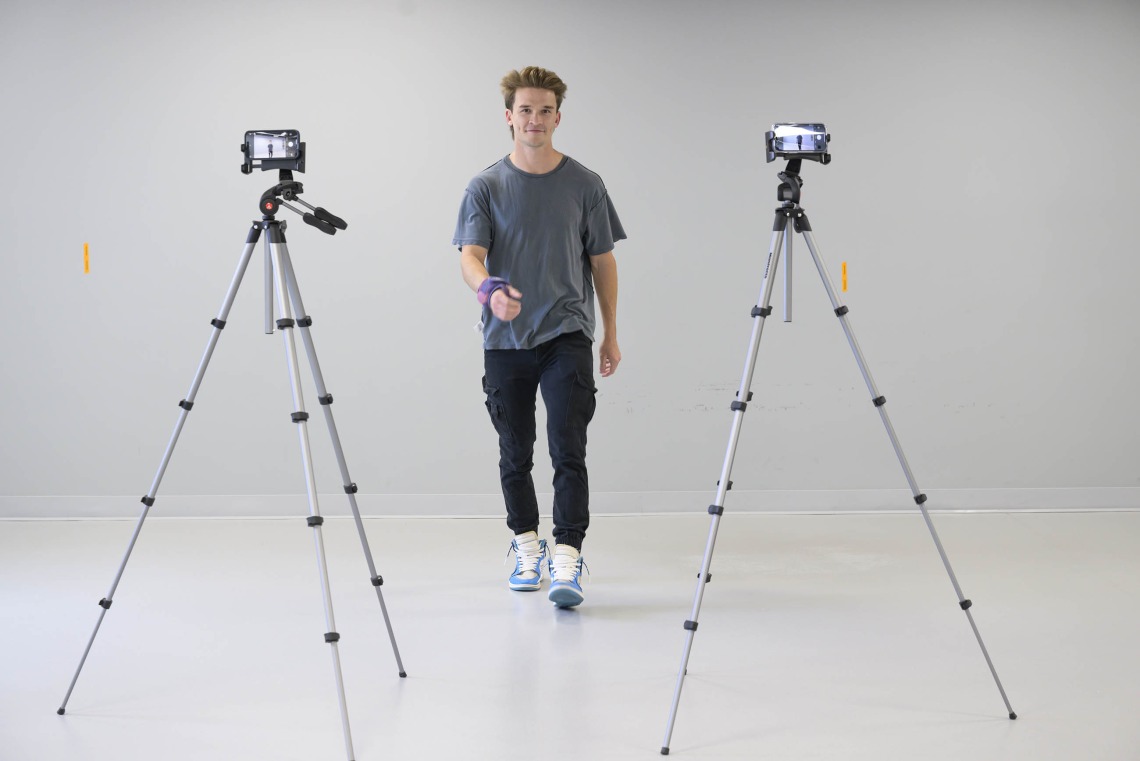A new perspective to prevent falls in older adults
Jonathan Lee-Confer, PhD, believes that strengthening arms – in addition to legs – could help older adults lower their risk of dangerous and debilitating falls.

Collecting data on the body’s movements is a key step in designing clinical interventions, says Jonathan Lee-Confer, PhD, who is conducting research at the University of Arizona College of Health Sciences to better understand how people fall.
Beginning in the 1990s, television commercials popularized a line to sell an emergency alert pendant for older adults to wear and activate in the event of a fall: “Help! I’ve fallen and I can’t get up.”

Jonathan Lee-Confer, PhD, hopes to use his research to design interventions for older adults that could prevent serious injury from falls and reduce the risk of falling.
The advertisements may no longer be mainstream three decades later, but the need for such services remains. On average, at least one person age 65 or older falls every second of every day, according to the Centers for Disease Control and Prevention. That adds up to more than 36 million falls per year, with approximately 32,000 of those resulting in death.
The CDC offers a fact sheet with three simple things that older adults can do to lower their risk of falling. They include talking to health care providers, making your home safer and staying active. For the latter, the CDC suggest that people “do exercises that make your legs stronger and improve your balance (like tai chi).”
Strengthening legs to improve balance and reduce the risk of falling has been a predominant area of study. At the University of Arizona Health Sciences, Jonathan Lee-Confer, PhD, assistant professor in the Doctor of Physical Therapy program at the University of Arizona College of Health Sciences, wants to change that paradigm.
He believes strengthening the arms may also be beneficial to prevent falls and authored a perspective article published in Frontiers in Sports and Active Living to introduce the idea.
“Current physical therapy protocols strengthen the legs to improve balance; however, arm movements also help maintain balance during a slip incident. Understanding how arm movements improve balance may help clinicians develop more comprehensive fall-prevention protocols to improve patient outcomes,” Lee-Confer wrote.
New focus, new questions
Lee-Confer became interested in the field of physical therapy as an undergraduate student at California State University, Sacramento. He went on to work as a research technical assistant at a skilled nursing facility where many of the older adult patients often came in with hip fractures, many of which occurred during a slip or fall. Patients were required to complete a rigorous eight- to 12-week recovery plan, a mental and physical toll that was not lost on Lee-Confer.

A sideways loss of balance is a common cause of falls in older adults.
“It was a pretty intensive experience to see them depressed, not wanting to work out and feeling as if they had lost their sense of freedom,” Lee-Confer said.
As a result, Lee-Confer’s career interests began to focus less on the rehabilitation of patients and more on prevention strategies that could keep them out of the clinic in the first place. He began studying past research on fall prevention and soon realized the primary focus was on the legs – only a few studies investigated the role of the arms in falls.
“There was a huge gap in the literature,” Lee-Confer said. “Intuitively, I thought to myself about how the arms can move and swing when someone loses balance. I wanted to know if the arms are helpful in a slip incident, and I wanted to see if there was something missing in the field.”
Cause and effect
Lee-Confer took his curiosity to the University of Southern California, where he completed several studies while obtaining a doctorate in biokinesiology with an emphasis in biomechanics. Each study built on the prior as he attempted to answer whether the arms are helpful when someone slips.
Using younger adults, the first study set out to show how the arms move during a fall. Lee-Confer said the prior research he came across suggested that when a person falls, there is a backward loss of balance, and the arms swing forward to try and correct that loss of balance by bringing the body forward. His research came to a different conclusion that explained why he used to see so many patients recovering from hip fractures in the clinical setting.
“In our study, we started seeing people fall to the side. If you fall on your side, you land on your side and can fracture your hip. We found that the arms go to the side, not forward, to try and counter the sideways loss of balance.”
Next, Lee-Confer wanted to know the role the arms play in preventing a fall. He designed another study that looked at fall rates of participants walking with both arms free compared to individuals with their arms constrained to their sides during a slip incident. The research team found that restricting both arms created a fall rate that was three times higher than when both arms were free. They also found the same rate of increased falling for those study participants who fell to the same side that their arm was restricted. However, if the free arm was in the same direction that they were falling, the fall rate was the same as if both arms were free.
“We can’t stop all injuries, but we can use them to inform our research.”
—Jonathan Lee-Confer, PhD
These findings led Lee-Confer to better understand how the arms can help in the event of a slip. He examined several mechanistic studies that documented the cause and effect.
“We saw that if you are rotating your body to the side and you swing your arm, you reduce the distance your body goes to the side by three inches. That is close to the width of someone’s foot, which is a pretty big deal for trying to stay balanced,” he said.
Prevention by intervention
Lee-Confer is continuing this line of research at UArizona Health Sciences and now has data on arm movement in older adults. He said that in a sideways loss of balance, older adults move four inches further than younger adults. In addition, data shows that older adults accelerate their arms significantly slower than younger people. This helps explain the increased risk of falls and the accompanying rise in risk for hip fractures in older adults.

Lee-Confer believes that arm abduction exercises could help older adults raise their arms to the side faster during a fall, which may prevent some serious falls.
“We want to develop an intervention study to see if we can train the arms,” Lee-Confer said. “For example, if we have someone train by doing quick arm swings to their side, will that make their arms quicker and will that translate to being helpful in a slip incident?”
Lee-Confer’s research in fall prevention is expanding to include the interlimb coordination between arms and legs that exists during rhythmic, cyclical activities such as walking, but not while standing or sitting. He is also exploring the effects of dry contaminants on certain types of surfaces that may make them more slippery and, therefore, more dangerous for those at higher risk of suffering injuries from falling.
For now, Lee-Confer said, older adults could benefit with one simple, low-cost intervention: adding arm abductor exercises to the leg exercises commonly recommended by clinicians.
“We can’t stop all injuries,” Lee-Confer said, “but we can use them to inform our research that can hopefully make an impact in prevention that allows people to live longer and healthier lives.”
Experts
Jonathan Lee-Confer, PhD
Assistant Professor, Doctor of Physical Therapy Program, College of Health Sciences
Contact
Blair Willis
UArizona Health Sciences Office of Communications
520-419-2979, bmw23@arizona.edu

